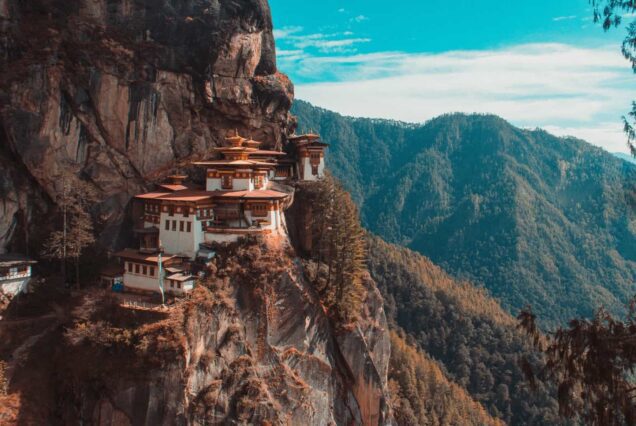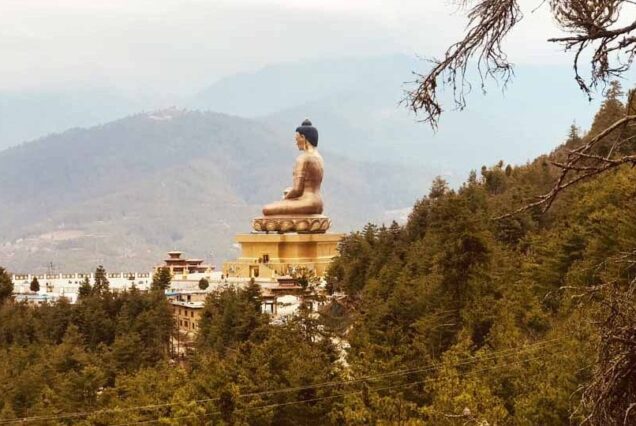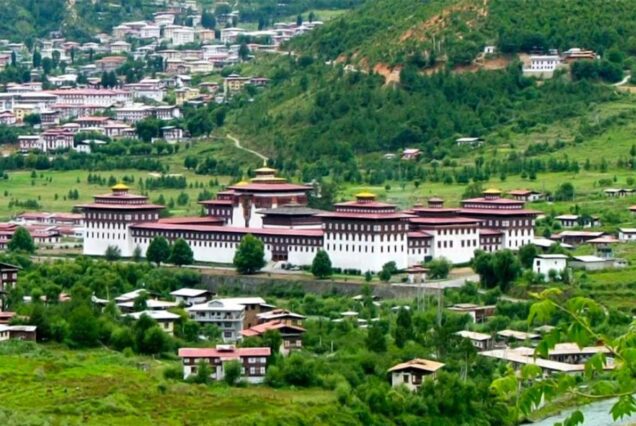Menu
Menu






AED 9350
6 Nights / 7 Days
| City | Nights | Category | Meal Plan |
|---|---|---|---|
| Thimphu | 2 | Thimphu Tower / Tashi Yid Wong | Breakfast & Dinner |
| Punakha | 2 | Hotel Lobesa/ Hotel Pema Karpo | Breakfast & Dinner |
| Paro | 2 | Bhutan Mandala Resort / Metta Resort/Similar | Breakfast & Dinner |
| Cost per Person | Prices |
|---|---|
| Double/Twin sharing for SAARC Nationals | AED 9350 |
Day 1: Arrival at Paro and Drive to Thimphu
The flight to Paro is one of the most spectacular in entire Himalayas. Flying along the Himalayan range from Kathmandu, the journey offers fascinating views and an exciting descent into the Kingdom. Bhutan’s first gift, as you disembark from the aircraft will be cool, clean fresh mountain air. After immigration formalities and baggage collection, you will be met by our representative, and afterwards drive to Thimphu, the capital town of Bhutan with enroute stop at Chuzom, the confluence of Thimphu and Paro rivers. Three different style of stupas; Tibetan, Nepalese and Bhutanese adorn this confluence. Shortly before reaching Chuzom, you will see on your left TschogangLhakhang, “the temple of the excellent horse”. It is a private temple, built in 15th century, as the result of visitation from Balaha, the excellent horse, a manifestation of Chenrezig, the compassionate Buddha. On arrival in Thimphu, check into the hotel. The capital town of Bhutan and the centre of Government, religion and commerce, Thimphu is a unique city with unusual mixture of modern development alongside ancient traditions. With the population of about 90,000 it is perhaps still the world’s only capital city without a traffic light. Evening an exploratory walk around Thimphu Main Street and market area. Also visit the Local Crafts Bazaar, to browse through example of Bhutan’s fine traditional arts. Here you can buy hand-woven textiles, Thangkha paintings, masks, ceramics, slate and wood carvings, jewellery, interesting items made from local materials. Overnight at the hotel in Thimphu
Day 02: Thimpu Sightseeing
After breakfast, visit Buddha Point (Kuensel Phodrang). Located at a short drive from Thimphu city centre, visitors can get a good overview of the Thimphu valley from the Buddha point (KuenselPhodrang). You can pay your obeisance and offer prayers to the Buddha, the largest statue in the country and then walk around and take a glimpse of the valley. Commence the “Buddha Nature Train” from Buddha point to Changangkha Lhakhang (02 hours easy hike). The hike from Buddhapoint to Changangkha Lhakhang is the most popular one to see the locals of Bhutan and at the same time take a forest bath. As you hit the trail you will be greeted by thousands of prayer flags and welcomed by a pristine forest of pines, birch, and rhododendron trees. If you are lucky, you can encounter few wild pheasant and bore. The trail is well maintained and at some places along the trails Gazebos are set up from where you can have a spectacular view of Thimphu valley and ends at Changangkha Lhakhang. Continue visit the Changangkha Lhakhang, which is a fortress like temple and monastic school perched on a ridge above Thimphu, south of Motithang. The temple was established in 12th century on a site chosen by Lama PhajoDrugomShigpo, who came from Tibet. The central statue here is Chenrezig in a manifestation with 11 heads. From temple courtyard, there is fascinating view of Thimphu valley. After lunch, take a short drive (15 km) to Pangri Zampa, 16th century one of the oldest monasteries in Bhutan located just north of Thimphu. Here is a monastic school where Buddhist student’s monks learn Lamaism and astrology based on Buddhist philosophy. Further visit to Bhutan Post Office, the Postal Service in Bhutan was first launched on 10th October 1962 with the opening of a post office in Phuentsholing. In the same year, post offices also opened in Paro and Thimphu. Traditional Paper-making factory, which comprises of two enterprises; the unit in Thimphu produces traditional handmade paper from natural plants mainly from ‘Daphne’ plant species which is insect-resistant. The other unit in Jimina, 22 km from the centre Thimphu town, recycles waster papers. The traditional handmade papers are widely used for religious scripts, packing materials, hand-carry bags, lampshades, envelopes, calendars. The paper looks a lot like Japanese washi, and in fact a lot of Bhutanese paper is exported to Japan also.
Evening, visit Trashichhoedzong: This impressive fortress/monastery houses Secretariat building, the throne room of His Majesty, the King and various government offices. It is also the summer residence of Chief Abbot and central monk body. Overnight at the hotel in Thimphu.
Day 03: Thimphu – Punakha (75 kms / approx. 3 hours)
After breakfast at hotel, Drive to Punakha across Dochula pass (3O8Om). In Bhutan, the passes are marked by a large Bhutanese Chorten and prayer flag. Dochula pass offers the most spectacular view over the high peaks of the eastern Himalayas on a clear day. Enroute, proceed for the walking excursion to Chimi Lhakhang (from hotel it is about 15 minutes’ drive till motorable road and then walk starts through paddy fields and villages. This is total about 1½ hour walk, including both way). The Chimi Lhakhang, situated on a hillock in the centre of the valley, also known as the temple of fertility. It is widely believed that couples who do not have children and wanting one, if they pray at this temple, they are usually blessed with a child very soon. The trail leads across rice fields to the tiny settlement of Pana, meaning ‘field’. A walk through the village near the temple will give you rare glimpses into the daily life and lifestyle of the villagers. After checking into hotel, proceed to visit Punakha Dzong, a massive structure built at the junction of two rivers. It was the capital of Bhutan until 1955, and still serves as the winter residence of the monk body. Evening can be spent exploring Punakha village located right on the bank of river. Overnight at the hotel in Punakha.
Day 04: Punakha Sightseeing
After breakfast, hike up through fields of chilies, cabbages and rice along the banks of the Mo Chhu to Khamsum Yuelley Namgyal Chorten, a stunning monument recently built by the Queens and consecrated in 1999. Later visit to Sangchhen Dorji Lhuendrup Lhakhang Nunnery. Perched on a ridge amid pine trees and overlooking valleys of Punakha and Wangdue Phodrang, gleams the magnificent structures of Sangchhen Dorji Lhuendrup Lhakhang(Temple). The temple houses a 14-foot main bronze statue of Avalokiteshvara (Chenrigzig chagtong chentong). Other statues include those of Guru Padma Sambawa, Gautama Buddha, Zhabdrung Ngawang Namgyel, Tsela Namsum, the 21 Taras and Tsepamay (Buddha of longevity). The Avalokiteshvara statue, one of the biggest in the country, was the handiwork of entirely local Bhutanese artisans. The temple complex also houses a permanent higher learning and meditation centre for nuns where, apart from religious trainings, it provides life skill training such as tailoring, embroidery, statue making and thangka painting. Overnight at the hotel in Punakha.
Day 05: Punakha – Paro (120 kms / approx. 4-5 hours)
After breakfast, check-out from the hotel and drive to Paro along scenic highway, enroute visit SimtokhaDzong, the oldest fortress of the country built in 1627 which now houses the School for Buddhist studies.
On arrival in Paro, check into the hotel. After lunch, proceed to visit Ta Dzong, originally built as Watchtower, which now houses National Museum. The extensive collection includes antique Thangkha paintings, textiles, weapons &armour, household objects and a rich assortment of natural and historic artifacts. Ta Dzong visit immediately followed by a short walk down the trail to visit Rinpung Dzong (ParoDzong), meaning (“fortress of the heap of jewels”), which has a long and fascinating history. Along the wooden galleries lining the inner courtyard are fine wall paintings illustrating Buddhist lore such as four friends, the old man of long life, the wheel of life, scenes from the life of Milarepa, Mount. Sumeru and other cosmic Mandala. Overnight at the hotel in Paro.
Day 06: Paro Sightseeing
After breakfast excursion to Taktshang Monastery or Tiger’s Nest (approx. 5 hours walk): It is one of the most famous of Bhutan’s monasteries, perched on the side of a cliff 900m above the Paro valley floor. It is said that Guru Rinpoche arrived here on the back of a tigress and meditated at this monastery and hence it is called ‘Tiger’s Nest’. This site has been recognised as a most sacred place and visited by ShabdrungNgawangNamgyal in 1646 and now visited by all Bhutanese at least once in their lifetime. On 19 April, 1998, a fire severely damaged the main structure of building but now this Bhutanese jewel has been restored to its original splendour. Afternoon drive to Drukgyel Dzong, a ruined fortress where Bhutanese warriors fought Tibetan invaders centuries ago. The snowy dome of sacred Chomolhari, “mountain of goddess” can be seen in all her glory from the approach road to the Dzong. Evening, visit the 7th century Kyichu Lhakhang, one of the 108 temples built in the Himalayas by Tibetan King, Songtsen Gampo. The building of this temple marks the introduction of Buddhism in Bhutan. Overnight at the hotel in Paro.
Day 07: Departure from Paro
After early breakfast at the hotel, drive to the airport for flight to your onward destination. Our representative will help you with exit formalities and then bid you farewell.
There are no reviews yet.

Get travel tips & offers straight into your inbox
Satguru Travel understands the importance of travel journeys, and that is why we have a 360 degree solution to travel.
Office No.104, 1st Floor, D- Tower Office , ADCP Building, Behind City Seasons Hotel, Electra Street, Abu Dhabi